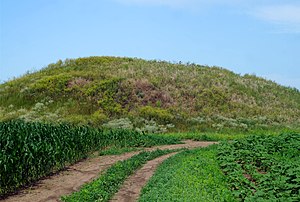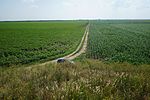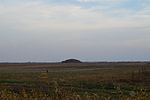Kinđa

Kinđa (
Geography
Top of Kinđa is at an altitude of 91 m (299 ft),[1] with the mound itself being elevated 5.3 m (17 ft) to 6 m (20 ft) above the surrounding ground. The mound is earthen, circular and has a diameter of 50 m (160 ft). Surrounding area is a low alluvial terrain, which used to be a marshland, so the village access road to the mound is impassable during the rainy seasons. Abundant running waters in the area either naturally meandered and eutrophicatied long time ago or were drained by the melioration in later times.
History
Even though Kinđа is officially declared an archaeological locality, no excavations have been done, due to its importance for the plant life. It is hypothesized that the mound originates from the Copper Age, during the period when
Another hypothesis, based on the condition of the mound and its appearance, is that it was built by the Cumans, in the 13th century. The Cumans settled in Europe fleeing the Tatars and were the last known culture to bury the dead under the kurgans.[4]
Name
The origin of the name is obscure and the true meaning can't be established for sure. The archaeological section of the Kikinda Museum claims that the name of the town is derived from the name of the mound (Kinđa - Kikinda), though this claim has not been universally accepted. Theories on the origin of the name are numerous, claiming possible sources from the Latin, Hungarian, Serbian, Romanian, Turkish and Old Slavonic languages.
Importance
Kinđa is the largest and was one of the best preserved kurgans in Serbia, which are all over 8 centuries old.
The mound is somewhat of a symbol of Kikinda.[2] A section of the municipality is named after it, so as a street and a neighborhood in the town itself. The mountaineering club in Kikinda is also named "Kinđa", as it is the highest elevation point in the region.
One of the reasons for the preservation of the mound's original shape is the lush, autochthonous vegetation which covers it. As the most of the land in Vojvodina is being used for extensive agriculture for centuries, Kinđa represents a genetic reserve for the original steppe and meadow flora.
2017 incident
Kinđa is not under the state protection and has not been declared a
Gallery
|
|
References
- ^ Jugoslavija - auto atlas. Yugoslav Lexicographical Institute. 1982. p. 8.
- ^ a b c d e J.T.C. (17 May 2017), "Poljoprivrednom mehanizacijom uništili arheološki lokalitet", Politika (in Serbian), p. 13
- ^ Kinđa - brdo gde mu mesto nije
- ^ Filip Krčmar (2011): Banat kroz vekove, u knjizi: Banat je kao priča (Zoran Slavić, ured.), Istorijski arhiv Zrenjanin - NIP Zrenjanin, Zrenjanin
- ^ Spomenik prirode "Jurišna humka" Studija zaštite Pokrajinski Zavod za zaštitu prirode, 2011, Novi Sad; p.4
- ^ Rada Šegrt (18 May 2017). "Odneli pola brda, greškom uništili praistorijsku humku i simbol Kikinde pa priznali: Slučajno smo". Blic (in Serbian).
External links
 Media related to Kinđa at Wikimedia Commons
Media related to Kinđa at Wikimedia Commons










